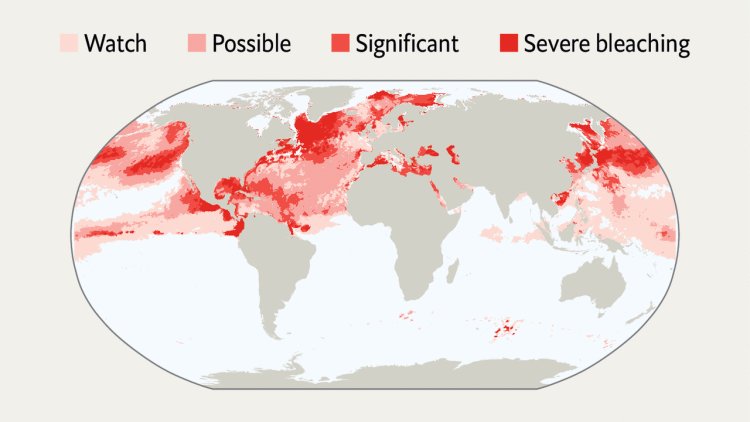Corals are bleaching and dying earlier in the year than ever before
Do abortion-related benefits help American firms recruit?A new paper shows that they attract some potential employees but may turn off othersTo read more of The Economist’s data journalism visit our Graphic detail page.ON JULY 24TH a buoy in the Manatee Bay off Florida’s southern tip measured a record-breaking sea-surface temperature of more than 101F (38°C). Normally, you’d need to take a bath to immerse yourself in water of that temperature. Beachgoers may not mind the warm waters now present off the coast of Florida and in many other places, but they are terrible for marine wildlife. Many underwater creatures will move to colder waters. For plants and animals that can move less freely, including corals, the high ocean temperatures are life threatening.According to America’s National Oceanic and Atmospheric Administration (NOAA), which monitors coral heat stress by satellite, parts of the ocean off the coast of Florida are experiencing the worst heat stress since records began in 198


Do abortion-related benefits help American firms recruit?
A new paper shows that they attract some potential employees but may turn off others
To read more of The Economist’s data journalism visit our Graphic detail page.
ON JULY 24TH a buoy in the Manatee Bay off Florida’s southern tip measured a record-breaking sea-surface temperature of more than 101F (38°C). Normally, you’d need to take a bath to immerse yourself in water of that temperature. Beachgoers may not mind the warm waters now present off the coast of Florida and in many other places, but they are terrible for marine wildlife. Many underwater creatures will move to colder waters. For plants and animals that can move less freely, including corals, the high ocean temperatures are life threatening.
According to America’s National Oceanic and Atmospheric Administration (NOAA), which monitors coral heat stress by satellite, parts of the ocean off the coast of Florida are experiencing the worst heat stress since records began in 1985. In the Florida Keys water temperatures have risen to dangerous levels for corals much earlier than in previous years, too (see chart). The NOAA has issued its highest alert level, signalling that strong bleaching events are likely, for large parts of the Caribbean (see map). The longer corals are in hot waters, the more likely they are to bleach and eventually to die. Bleaching events have already occurred this year off the coast of Central American countries, including El Salvador and Panama.

Corals are essential to marine life and support jobs. They provide breeding grounds, food or shelter to about a quarter of all marine species at some point in their lives, even though they cover less than 1% of the ocean floor. Reefs also break waves and protect shores from erosion. The fish they attract provide livelihoods to fishermen. Coral-related tourism generates about $36bn of spending each year.
As the climate warms, bleaching events are becoming more common and last longer. Reefs have already shrunk by half since 1957. The Intergovernmental Panel on Climate Change, a UN body, projects that they will decline by a further 70–90% with 1.5°C of warming above preindustrial levels. More than 99% could be lost in a scenario of 2°C of global warming.
This year El Niño, a natural climate phenomenon that temporarily warms the planet, will increase the risk to coral reefs. Strong El Niños can lead to severe marine heatwaves and bleach reefs across the tropics. The last time this happened was between 2014 and 2017. The NOAA forecasts that the marine heatwave will spread in September and October this year, by which time 50% of the world’s oceans could be experiencing extreme heat, up from 44% now.
Scientists and conservationists are racing to help save them. Divers from the Coral Restoration Foundation, a charity that works with the NOAA and aims to preserve Florida’s coral reefs, have evacuated 2,500 corals to tanks on land. This effort may save some endangered species, but it is just a tiny fraction of the total. Conservation groups in Florida are also considering proposals to save coral reef “nurseries”—where corals are grown on land and at sea to restock wild reefs—by temporarily shading them. The evacuated corals will eventually return to their waters. But if the average ocean temperature continues to rise as a result of climate change, they may not be safe for long.■
What's Your Reaction?













